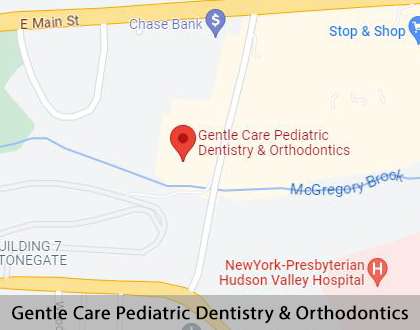Nerve Treatment Options Peekskill, NY
Dental nerve pain can be frightening and upsetting. If your child develops oral pain, seek help immediately A pediatric dentist can identify the cause of their discomfort. Dental nerve treatments can resolve pain, eliminate infection and preserve damaged teeth.
Pediatric dentists are available at Gentle Care Pediatric Dentistry & Orthodontics in Peekskill and the surrounding area. Our team offers a range of treatments for dental pain. We get to the root of the problem and resolve even stubborn dental problems. Call us at (914) 930-4465 to learn more.
Nerve Treatment in Babies and Young Children
Cavities are a common concern among children. Even children who practice good oral hygiene can develop tooth decay. But once a cavity has appeared, it must be filled. If a cavity is not fixed, decay can spread, and lead to infection. The nerves at the base of the tooth can become infected and inflamed. An affected child might experience debilitating tooth and jaw pain.
Fortunately, treatment can resolve this issue. Treating infected teeth is sometimes called pulp therapy or nerve therapy. During this procedure, dentists remove the decay. They clean out the infected pulp and apply medicine. Then they seal the tooth.
Pulp therapy can help preserve baby teeth until they are shed naturally. Although these teeth are eventually shed, dentists prefer to keep them in place if possible. Baby teeth should remain until the permanent teeth are ready to erupt. If a child loses their baby teeth too early, they might develop orthodontic problems.
“Pulp therapy can help preserve baby teeth until they are shed naturally.”
Understanding Dental Pulp
The inside of the tooth holds a fleshy material called the pulp. The dental pulp connects the roots, blood vessels, and nerves inside the tooth. It helps keep teeth alive and settled firmly within the jawbone. Pulp plays an important role in oral health.
Unfortunately, the pulp can sometimes become infected. An accident or severe cavity can lead to infected pulp. Once infection sets in, the pulp may need to be removed. A dentist can scoop out the infected pulp and fill the tooth. This treatment can stop the infection in its tracks.
“Pulp connects the roots, blood vessels and nerves inside the tooth.”
Understanding Root Canals
If a child has extensive decay or damage, they might need a root canal. Root canals can sound frightening. But modern dentistry has made this procedure much simpler than before. Thanks to numbing medications, patients feel little to no pain during their procedure.
During a root canal, the dentist drills into the decayed tooth. They remove all the pulp and shape the inside of the tooth. Next, they fill the tooth with a solid material. Finally, the dentist places a crown on the tooth to protect it.
Root canals are safe for both children and adults, but dentists usually perform the procedure only on permanent teeth. If the child has a damaged or decayed baby tooth, the dentist may suggest another treatment. A pulpotomy or pulpectomy might be a better choice.
“Root canals are safe for both children and adults, but dentists usually perform the procedure only on permanent teeth.”
Check out what others are saying about our dental services on Yelp: Nerve Treatment Options in Peekskill, NY
Pulpotomy and Pulpectomy
In a pulpotomy, dentists remove only part of the pulp. The remaining pulp, along with the roots, is kept intact. The dentist fills the tooth with a biocompatible material. Finally, they cover the tooth with a protective cap.
Pulpotomies are sometimes known as baby root canals. They provide similar results to a root canal, but they are less invasive. Pulpectomies are a little more extensive. During this procedure, the pulp is entirely removed. Then the doctor fills the tooth and applies a cap.
The goal of these procedures is to save the baby tooth. The dentist tries to keep the tooth intact until the permanent tooth comes in. If the tooth is not salvageable, the dentist may opt to extract it. The dentist can provide a space maintainer to help keep the remaining teeth in place.
Common Terms and Phrases
A pediatric dentist may perform some additional procedures during a pulpectomy or pulpotomy. These procedures are usually designed to protect the tooth's roots or get rid of the infection. They can include:
- Apexogenesis: This procedure encourages the root to continue developing. The dentist applies medication to the pulp to encourage the healing process. This treatment can help save a tooth.
- Apexification: During this procedure, the dentist removes the diseased pulp. Then they put medication into the tooth’s root. It hardens tissue near the root, providing a barrier. It can help preserve the tooth if the roots are not fully formed.
- Apicoectomy: This procedure removes the tip of the tooth’s root. It can help clear up a stubborn infection that persists after a root canal. This procedure is generally the last option before an extraction.
“The goal of these procedures is to save the baby tooth.”
Questions Answered on This Page
Q. What causes dental nerve pain in young children?
Q. What is the difference between a pulpotomy and a pulpectomy?
Q. What are some warning signs of dental nerve problems?
People Also Ask
Q. What is a pediatric dental emergency?
Q. How do I find the right dentist for my child?
Q. How does pediatric dental technology make pediatric dentistry easier?
Symptoms to Watch Out For
Parents should see a dentist right away if their child develops tooth pain. If the dentist finds a cavity, get it filled as soon as possible. Pulp infections often develop after an untreated cavity. Early treatment can eliminate the need for pulp therapy.
But sometimes, nerve pain can develop without warning. Dental nerve pain often feels sharp or sudden. Some patients describe the pain as an electric jolt. Others report a dull, constant throb. Patients might notice that their pain worsens when chewing or with exposure to heat or cold.
Parents should report their children's pain to a pediatric dentist immediately. The dentist can make a diagnosis and arrange treatment. The sooner treatments take place, the faster the child's pain will be resolved.
“Parents should report their children’s pain to a pediatric dentist immediately.”
Frequently Asked Questions
Q. What causes nerve problems?
A. Nerve pain or nerve damage can occur after an injury. A cracked or broken tooth is vulnerable to infection. Problems can also develop due to an untreated cavity. If a cavity is not filled, decay can spread into the pulp. Once the pulp becomes infected, patients usually develop stubborn tooth pain. A pediatric dentist will need to remove the infected pulp to save the tooth.
Q. What are some symptoms of nerve problems?
A. Your child may have trouble chewing or drinking. They might notice stubborn tooth pain or pain that worsens with exposure to hot or cold. Any dental pain should be reported to your provider right away. A pediatric dentist can determine what is causing the pain and how to treat it.
Q. What are the treatment options?
A. If the pain is linked to a pulp infection, your child might need a pulpectomy or pulpotomy. During this procedure, the pediatric dentist clears away the infected pulp. They may provide other treatments to protect or preserve the roots. Then they fill the tooth and cover it with a cap.
Q. Does my child need a root canal?
A. In general, pediatric dentists do not perform root canals on baby teeth. But similar procedures can deliver good results. The dentist can remove the infected pulp and resolve stubborn nerve pain.
Q. What happens if the tooth cannot be saved?
A. If a baby's tooth is severely damaged or decayed, the pediatric dentist may decide to pull it. This is not always the right option. But in some cases, an extraction might be unavoidable. Afterward, the dentist may decide to insert a space maintainer. This appliance can help prevent problems that come with too-early tooth loss.
Quality Pediatric Dental Services Can Transform Smiles
By visiting us as soon as possible, our team can help get your child the professional treatment they need.
Definition of Pediatric Dental Terminology
Call Us Today
Nerve pain is often a sign of a developing cavity. While discovering a cavity can be annoying and disappointing, many children experience them. If your child has severe decay or an infection, the dentist can help. Pulp therapy can remove the infection and protect your child's dental health.
If you are looking for a new pediatric dental provider, let Gentle Care Pediatric Dentistry & Orthodontics in Peekskill help. Call us at 914-930-4465 to learn more about our services and policies.
If you live in the Peekskill area, call 914-930-4465 for an appointment in our Peekskill office.
Helpful Related Links
- American Dental Association (ADA). Glossary of Dental Terms. 2023
About our business and website security
- Gentle Care Pediatric Dentistry & Orthodontics was established in 2009.
- We accept the following payment methods: American Express, Cash, Check, Discover, MasterCard, and Visa
- We serve patients from the following counties: Westchester County and Putnam County
- We serve patients from the following cities: Peekskill, Garrison, Cortlandt Manor, Mohegan Lake, Yorktown Heights, Buchanan, Verplanck, Montrose, Putnam Valley, Jefferson Valley, Croton-on-Hudson, Beacon, West Point, Shrub Oak, and Mahopac
- Norton Safe Web. View Details
- Trend Micro Site Safety Center. View Details
Back to top of Nerve Treatment Options







